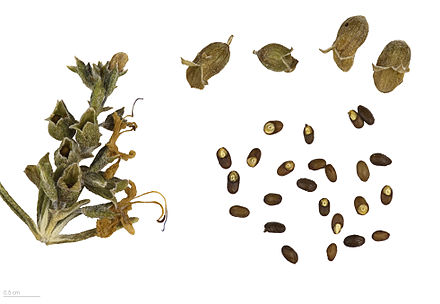 Salvia rosmarinus, commonly known as rosemary, is a woody, perennial herb with fragrant, evergreen, needle-like leaves and white, pink, purple, or blue flowers, native to the Mediterranean region. Until 2017, it was known by the scientific name Rosmarinus officinalis, now a synonym. It is a member of the mint family Lamiaceae, which includes many other herbs. The name “rosemary” derives from Latin ros marinus (“dew of the sea”). The plant is also sometimes called anthos, from the ancient Greek word ἄνθος, meaning “flower”. Rosemary has a fibrous root system. The first mention of rosemary is found on cuneiform stone tablets as early as 5000 BC. After that not much is known, except that Egyptians used it in their burial rituals. There is no further mention of rosemary until the ancient Greeks and Romans. Pliny the Elder (23–79 AD) wrote about it in The Natural History, as did Pedanius Dioscorides (c. 40 to c. 90), a Greek botanist (amongst other things). He talked about rosemary in his most famous writing, De Materia Medica, one of the most influential herbal books in history. The herb then made its way east to China and was naturalized there as early as 220 AD, during the late Han Dynasty.
Salvia rosmarinus, commonly known as rosemary, is a woody, perennial herb with fragrant, evergreen, needle-like leaves and white, pink, purple, or blue flowers, native to the Mediterranean region. Until 2017, it was known by the scientific name Rosmarinus officinalis, now a synonym. It is a member of the mint family Lamiaceae, which includes many other herbs. The name “rosemary” derives from Latin ros marinus (“dew of the sea”). The plant is also sometimes called anthos, from the ancient Greek word ἄνθος, meaning “flower”. Rosemary has a fibrous root system. The first mention of rosemary is found on cuneiform stone tablets as early as 5000 BC. After that not much is known, except that Egyptians used it in their burial rituals. There is no further mention of rosemary until the ancient Greeks and Romans. Pliny the Elder (23–79 AD) wrote about it in The Natural History, as did Pedanius Dioscorides (c. 40 to c. 90), a Greek botanist (amongst other things). He talked about rosemary in his most famous writing, De Materia Medica, one of the most influential herbal books in history. The herb then made its way east to China and was naturalized there as early as 220 AD, during the late Han Dynasty.

Rosemary came to England at an unknown date; the Romans probably brought it when they invaded in the first century, but there are no viable records about rosemary arriving in Britain until the 8th century. This was credited to Charlemagne, who promoted herbs in general, and ordered rosemary to be grown in monastic gardens and farms. Furthermore, there are also no records of rosemary being properly naturalized in Britain until 1338, when cuttings were sent by The Countess of Hainault, Jeanne of Valois (1294–1342) to Queen Phillippa (1311–1369), wife of Edward III. It included a letter that described the virtues of rosemary and other herbs that accompanied the gift. The original manuscript can be found in the British Museum. The gift was then planted in the garden of the old palace of Westminster. After this, rosemary is found in most English herbal texts, and is widely used for medicinal and culinary purposes. Rosemary finally arrived in the Americas with early European settlers in the beginning of the 17th century. It soon was spread to South America and global distribution.

 Deutsch
Deutsch